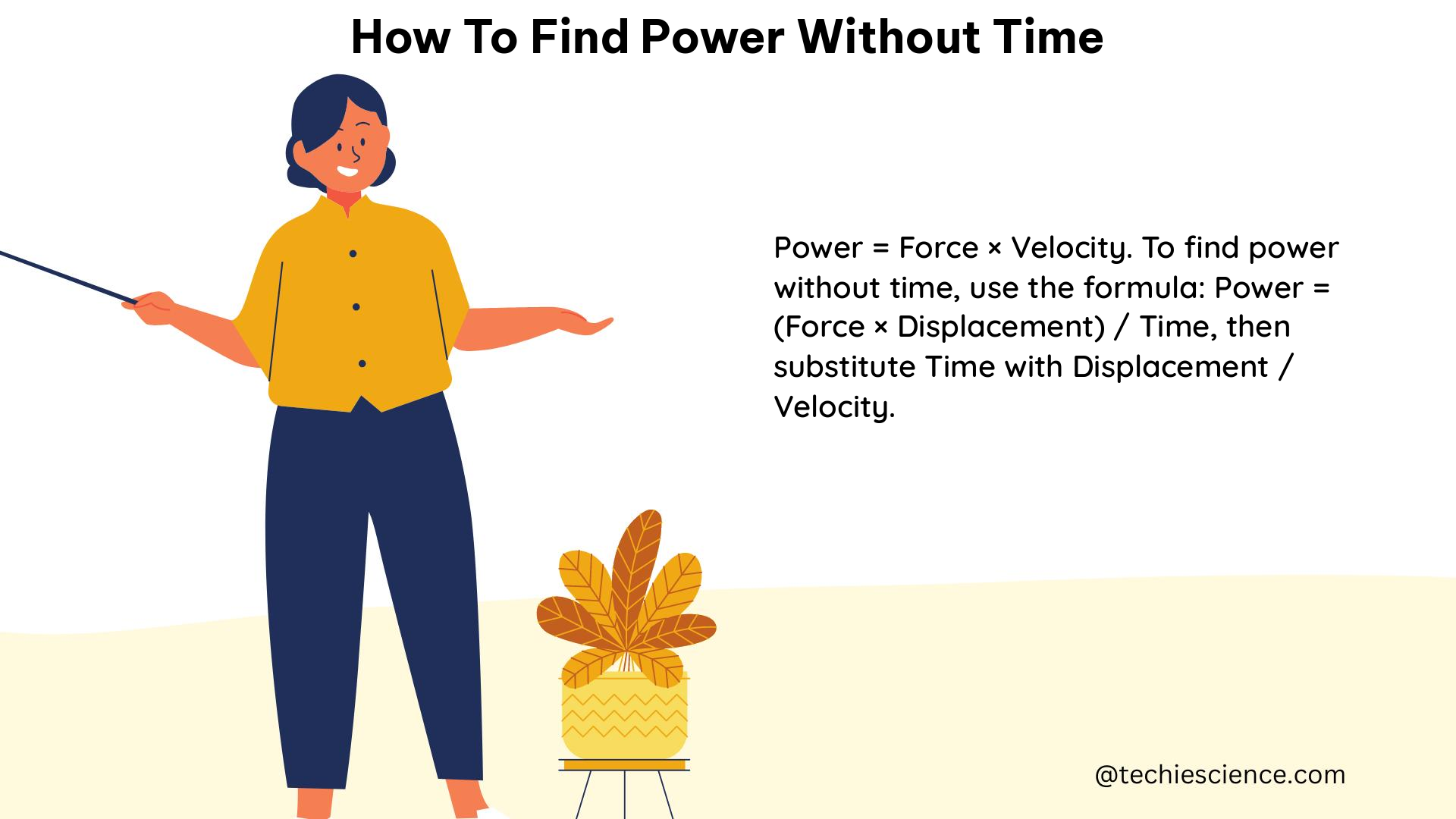Summary
To find power without time, we can use the formula for power, P = W/t, where P is power, W is work, and t is time. However, when the time taken is not given, we can calculate power using the formula P = Fv, where F is the force applied and v is the velocity of the object. This approach involves calculating the force, work, and constant velocity to determine the power output without explicitly knowing the time taken.
Understanding Power and Work

Power is defined as the rate of doing work, or the amount of work done per unit time. The formula for power is:
P = W/t
Where:
– P is power (in watts, W)
– W is work (in joules, J)
– t is time (in seconds, s)
Work, on the other hand, is the product of force and displacement. The formula for work is:
W = Fd
Where:
– F is the force applied (in newtons, N)
– d is the distance traveled (in meters, m)
Calculating Power Without Time
When the time taken is not given, we can use the formula for power in terms of force and velocity:
P = Fv
Where:
– F is the force applied (in newtons, N)
– v is the velocity of the object (in meters per second, m/s)
To use this formula, we need to find the force applied and the velocity of the object.
Step 1: Calculate the Force
If the object is moving at a constant velocity, we can assume that the net force acting on the object is zero. This means that the force applied by the object is equal and opposite to the force of gravity acting on the object.
The force of gravity can be calculated using the formula:
F = mg sin(θ)
Where:
– m is the mass of the object (in kilograms, kg)
– g is the acceleration due to gravity (9.8 m/s²)
– θ is the angle of the incline (in radians)
Step 2: Calculate the Work
Once we have the force, we can calculate the work done by the object using the formula:
W = Fd
Where:
– F is the force applied (in newtons, N)
– d is the distance traveled (in meters, m)
Step 3: Calculate the Velocity
Since the time taken is not given, we can use the formula for velocity:
v = d/t
Where:
– d is the distance traveled (in meters, m)
– t is the time taken (in seconds, s)
Rearranging this formula, we can solve for the time:
t = d/v
Step 4: Calculate the Power
Finally, we can calculate the power using the formula:
P = Fv
Where:
– F is the force applied (in newtons, N)
– v is the velocity of the object (in meters per second, m/s)
Substituting the values, we get:
P = (F)(d/t)
P = (F)(d)/(d/v)
P = Fv
Example Problem
Let’s consider the example of the lawn tractor going up a hill at a constant velocity, as described in the original answer.
Given:
– Mass of the tractor, m = 120.0 kg
– Acceleration due to gravity, g = 9.8 m/s²
– Angle of the incline, θ = 21 degrees
– Distance traveled, d = 12.0 m
Step 1: Calculate the Force
F = mg sin(θ)
F = (120.0 kg)(9.8 m/s²)sin(21 degrees)
F = 421.4 N
Step 2: Calculate the Work
W = Fd
W = (421.4 N)(12.0 m)
W = 5056.8 J
Step 3: Calculate the Velocity
Since the tractor is moving at a constant velocity, the net force acting on it is zero. This means that the force applied by the tractor is equal and opposite to the force of gravity.
Assuming the force applied by the tractor is constant, we can use the formula:
P = Fv
Substituting the values, we get:
P = (421.4 N)v
Since the power output of the tractor is constant, we can also calculate it as:
P = W/t
P = 5056.8 J / (12.0 m / v)
P = (421.4 N)v
Solving for the velocity, we get:
v = 5056.8 J / (12.0 m × 421.4 N)
v = 0.914 m/s
Step 4: Calculate the Power
P = Fv
P = (421.4 N)(0.914 m/s)
P = 385.3 W
Therefore, the power developed by the tractor is 385.3 Watts, without explicitly knowing the time taken.
Additional Considerations
- This approach can be used to compare the power output of different exercises or workouts, even if they are performed at different speeds or for different durations.
- In the context of CrossFit, power is an important metric used to measure the intensity of a workout. By calculating power without time, we can get a more accurate reflection of the intensity of the workout.
- The constant velocity assumption is crucial in this method. If the object is not moving at a constant velocity, the net force acting on it would not be zero, and the calculations would need to be modified accordingly.
References
- Defining CrossFit, Part 2: Intensity, CrossFit.com
- How to Calculate Power Based on Force and Speed, Dummies.com
- Finding power without given speed or time, Physics Forums

The lambdageeks.com Core SME Team is a group of experienced subject matter experts from diverse scientific and technical fields including Physics, Chemistry, Technology,Electronics & Electrical Engineering, Automotive, Mechanical Engineering. Our team collaborates to create high-quality, well-researched articles on a wide range of science and technology topics for the lambdageeks.com website.
All Our Senior SME are having more than 7 Years of experience in the respective fields . They are either Working Industry Professionals or assocaited With different Universities. Refer Our Authors Page to get to know About our Core SMEs.